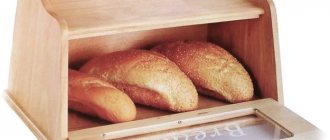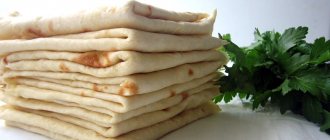Products such as bread and salt are always available in every home. However, while salt can be stored for years under certain conditions, bread remains fresh and edible for only a few days. Is it possible to stock up on it for future use without letting it go stale and moldy? Frozen bread, along with fish, meat or berries, will wait its turn in the freezer without losing its taste.
Can bread be stored in the refrigerator?
When the air temperature rises above 25 0C, the product begins to dry out, become stale and disappear. If the bread was purchased in large quantities and you do not have the opportunity to consume it within 1-2 days, then it is recommended to use the refrigerator to maintain its freshness. In this case, it is necessary to observe certain storage conditions that prevent the product from absorbing foreign odors, excessive waterlogging of the crust and the appearance of mold.
You can keep the bread in an edible state by leaving it in the freezer. This storage method extends the shelf life by 1-4 months. and will protect other products from getting yeast spores on them.
Features of storing bread in the refrigerator
To maintain the freshness of the product before putting it in the refrigerator, you need to take into account some nuances:
- when opened, the bread will absorb foreign odors and moisture, so it must first be placed in a plastic bag, food foil or a fabric bag;
- The packaging should not be completely sealed, otherwise it will create a “greenhouse effect” and the product will become moldy;
- shelf life in the refrigerator is 3 weeks;
- when choosing packaging for storing bread, preference is given to paper or fabric bags; they are able to allow air to pass through and prevent the absorption of odors from other products;
- Only cooled bread is placed in the refrigerator; if it is hot, it will quickly become moldy even in porous packaging;
- Baked goods made with yeast should be placed separately.
Attention! Moldy bread should not be stored in the refrigerator, as the fungus can spread to other foods.
The benefit of this storage method is to slow down the evaporation of moisture from the bread, which prevents the formation of mold and extends its shelf life. But if the established rules are not followed, this option for containing the product can be harmful to it. If you place hot baked goods in the refrigerator, the moisture will begin to evaporate faster, the baked goods will become stale and lose their taste.
There is no need to constantly store bread in the refrigerator. Use this method only if it is impossible to consume it within 1-2 days, since during this period it is able to maintain its freshness at room temperature.
Disadvantages of storing flour products in the refrigerator
@legkovmeste.ru
Reasons why the refrigerator is questionable as a place to store baked goods:
Moisture absorption
Bread is a hygroscopic product. The low temperature and humid environment in the refrigerator cause water vapor to evaporate, thereby forming condensation. The hygroscopic property of the product stimulates it to absorb moisture abundantly. A loaf saturated with moisture loses its pleasant taste and quickly begins to stale.
Mold occurrence
High humidity is a prerequisite that causes the growth and development of pathogens and fungi. This affects the appearance of mold on the product. It is also important that dough prepared with yeast is subject to subsequent fermentation, and the acidic environment promotes intensive mold growth.
Also, bread quickly spoils in a plastic bag. In a closed space, it begins to rot and becomes not only tasteless, but also harmful to health.
The appearance of odors
In addition to moisture, the baked product absorbs pulp and odors. A loaf that has been stored in the refrigerator may taste like food stored next to it. Such a bun becomes tasteless and is unpleasant to eat.
How to freeze bread
Placing the product in the freezer helps extend the shelf life by 1-4 months, but even under these conditions it cannot be stored for long. After the end of the specified period, it should be consumed within 1-2 days.
It is recommended to freeze bread by doing the following:
- The product is sent to the freezer only when fresh, but not hot. If you place it in a dry state, it will be tough and lose flavor when removed. Hot bread will quickly absorb moisture, become covered with frost and remain wet after defrosting.
- For freezing, you need to choose special bags made of thick film, which protect the product from drying out and absorbing foreign odors.
- Bread is packaged in a volume equal to one serving, since frequent freezing and temperature changes will lead to the fermentation process and spoilage of the product.
- Release the air and wrap the bag tightly. To increase storage time, use several packages at once.
- The temperature in the freezer is set to -18 0C
Attention! If you freeze the bread at different times, write the date on each bag. Place the fresher product towards the back wall, which will allow you to consume it later.
Many people are tormented by the question of whether bread from the freezer is healthy. If all storage conditions for the product have been met, then after defrosting there will be no changes in its composition. Its beneficial properties remain the same as before freezing.
The disadvantage of this storage is that the product quickly becomes stale when defrosting in the oven or microwave. For this reason, it is recommended to store it in a bag in pieces, the number of which corresponds to a serving for 1 meal.
Some are sure that the calorie content of frozen bread is reduced by an order of magnitude, but this is just a myth. The energy value of the product remains unchanged. It is initially lower in baked goods made from wholemeal flour, so those who want to lose weight are advised to eat gray or black bread.
Freezing rules
In our country, bread has long been treated with great respect. Even when it starts to go stale, you don’t dare throw it away. Usually in these cases, housewives make crackers and croutons from bread. But if there is no use for the fresh product yet, it is better to freeze its excess and thereby save it from spoilage. Freezing bread is not difficult, but you need to know some rules.
- Under no circumstances should you freeze hot, freshly baked bread, as it will freeze very hard and will be wet after defrosting.
- You should also not put an old, already stale loaf in the freezer. Subsequently, it will turn out to be too hard, and its taste may change.
- You need to freeze the bread in such portions that after defrosting you can eat it all. Bread cannot be re-frozen.
- Regular bread is great for freezing, but tender, soft rolls do not tolerate frost as well. Therefore, it is better not to subject buns with a loose consistency, fluffy loaves and airy biscuits to this procedure.
How to defrost bread after freezing
There are various ways to perform this action. If the bread was frozen as a whole loaf, then defrost it as follows:
- Take the product out of the package and leave it on the table to thaw at room temperature (about 2-4 hours). With this method, it will only defrost, but will not become warm. How soft the bread is is checked by pressing on the loaf.
- The oven defrosting method allows you to reheat the product and return it to the state of fresh baked goods. The temperature is set to 175 degrees. The bread is removed from the bag and placed on a baking sheet, which is placed on the middle shelf of the oven. The timer is set for 40 minutes. After the process, the bread is left to cool at room temperature.
If after defrosting the crust becomes stale, then it is softened in the following way:
- Sprinkle the bread with water or wipe with a wet paper towel, and then remove excess moisture with a dry one;
- wrap the wet product in foil so that it hugs it tightly and does not release moisture;
- place the bread on the middle shelf of the oven;
- set the temperature to 150 degrees;
- large loaves are kept in the oven for 30 minutes, and rolls and baguettes - 20 minutes;
- Remove the foil from the product and return it to the oven until crispy (5 minutes).
If freezing was carried out in pieces, then take out the required amount of product. Bread slices are defrosted in the following ways:
- On the table at room temperature – 20 minutes.
- Place the pieces on a baking sheet and leave them in the oven at 200 degrees for 5 minutes. If it is necessary to obtain a crispy crust, the time is increased to 20 minutes, but it is pre-moistened with water.
- Place the bread in a frying pan and heat it for 3-5 minutes. over low heat without adding oil.
- Place the pieces in the toaster compartments and heat them until done. At the same time, you need to make sure that the slices do not burn;
- Place the pieces on a microwave-safe plate so that they do not touch. According to bakers, the slices should first be wrapped in paper towels. Set the maximum power level, warm up for 10 seconds. Check the degree of defrosting and, if necessary, send it back to the oven. Ready time depends on the microwave model. Usually 15-25 seconds is enough. The staleness and stickiness of the product after this method of defrosting are due to drying and increased evaporation of moisture from it.
You need to eat bread from the freezer within 1-2 hours or it will go stale again.
Tips for freezing bread
If you plan to eat the loaf of bread in portions, cut the slices to the desired thickness before placing them in the freezer. This will allow you to get the amount you need in the future.
Save time by baking multiple loaves of bread and freezing the slices separately.
Frozen bread
Prepare for the holiday table, prepare your bread and rolls a few weeks before guests arrive, and save your bread. Then defrost them in the refrigerator the night before the event and reheat them just before serving.
See also: Seeds and nuts: benefit or harm?
Freeze bread dough instead of ready-made breads. This will take up less space and allow you to enjoy freshly baked bread anytime. You can put it in the oven frozen. Just keep an eye on your bread towards the end of its baking, giving it extra minutes if necessary. You may find that it takes an additional 15 minutes to bake.
Where is it better to store bread in a bread bin or in the refrigerator?
When choosing where to store the product, you need to consider the following nuances:
- when black and white bread are placed simultaneously in a bread bin, the storage duration of the latter is significantly reduced;
- if you leave hot baked goods in the refrigerator, they will quickly become stale;
- temperatures above 25 0C will accelerate the spoilage of the product in the bread bin;
- when stored in the refrigerator, there is a high probability of absorption of third-party odors;
- If the equipment is made of wood, then there is a high probability of mold. To avoid this problem, you need to purchase aluminum or metal-plastic bread bins;
- The shelf life of bread, subject to all storage conditions at room temperature, is 3-5 days, in the refrigerator - about 3 weeks.
It is impossible to say unequivocally that one of the options for storing bread is better. It all depends on the conditions under which the product is kept and its volume. If you bought a lot of loaves, then you cannot place them in the bread bin at the same time; the ideal option would be a refrigerator.
Shelf life according to GOST
The assortment of bakeries is represented by various types of bread, for each of which, according to the system of state quality standards, a certain shelf life is established. The regulatory document determines the required period for the sale of the product, taking into account the type of flour, baking technology used in bakery production, and the weight of the product.
Shelf life of bread and bakery products in packaging according to GOST 31752-2012.
| Product name | Recommended implementation period |
| Bakery products made from rye flour or peeled flour, wheat flour, weighing no more than 0.2 kg (except for dietary products) | 5 days |
| Bakery products made from a mixture of wheat and rye flour weighing no more than 0.2 kg (except for dietary products) | 4 days |
| Bakery products made from premium, first, second grade wheat flour, semolina, sifted rye flour, weighing no more than 0.2 kg (except for dietary products) | 3 days |
| Salt-free peeled and rye diabetic bread, weighing 0.3 kg | 36 hours |
| Protein-free bread made from wheat starch and Barvikha, weighing 0.2 kg, Solovetsky and milk-bran, weighing more than 0.3 kg | 24 hours |
| Barvikha bread (up to 0.2 kg), Solovetsky bread (up to 0.3 kg), grain hearth bread, protein-wheat, protein-bran, diabetic rye (up to 0.3 kg), achloride hearth bread, buns and low-calorie wheat bread, Dietary bran bread with lecithin | 16 hours |
When the product is kept in a refrigerator at a temperature of -18 to -22 0C and a humidity level of up to 75%, the shelf life is 1-2 months.
Attention! If a longer shelf life is indicated on the packaging, this indicates the presence of preservatives in the baked goods.
How long bread can be stored depends on various factors. The location and conditions of the product play an important role. If the established rules are not followed, some methods may be harmful and will also accelerate its deterioration.
Video: how to store bread
THE BREAD WILL BE FRESH FOR WEEKS! How to store bread - a method from the Marmalade Fox
Watch this video on YouTube
Video: storing bread
Bread storage. How to extend the life of bread without spoiling it.
Watch this video on YouTube
Do you want to understand better than others?
- Features and shelf life of fresh and prepared mushrooms in the refrigerator - After harvesting mushrooms, you do not always have the strength to immediately process it. Therefore, there is a need to place the product in storage. Shelf life depends on the type and method...
- Features of storing flowers in the refrigerator and in room conditions - The life of flowers does not stop after cutting, but without a root, the decay of organic substances begins in them. The death of the plant depends on the speed of the process. To make it last as long as possible...
- How to properly store red caviar in the refrigerator and freezer - Red caviar can decorate any holiday table. Experienced housewives prefer to purchase it in advance, before the upcoming celebration and price increases. So that after long-term storage...
- Methods for storing lard in various forms in the refrigerator - Lard is animal fat in a solid state. The product is eaten in different ways of preparation: salted, smoked, boiled or fried. Depending on the…
- Is it possible to keep garlic in the refrigerator: 10 ways to store vegetables - Garlic is a crop characterized by a high degree of lightness. However, for its long-term storage it is necessary to create certain conditions: suitable temperature and humidity,…











